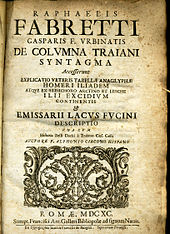Raffaele Fabretti
Raffaele (Raffaello, Raphael) Fabretti Urbinate , called Iasito Nafilio ( Jasitheus ) (born July 3, 1620 in Urbino , † January 7, 1700 in Rome ) was an Italian historian , antiquarian and archaeologist . He is considered one of the most important epigraphers of the 17th century and one of the fathers of Christian archeology .
Raffaele Fabretti first studied law in Cagli and Urbino and received his doctorate on May 10, 1639 in Cagli . He then worked in the legal department of the city of Rome. Here he developed his interest in epigraphic and archaeological topics through contacts with people such as Giovanni Giustino Ciampini and his Scientific Academy, which is under the patronage of Christina of Sweden , and later with the Accademia dell'Arcadia . Fabretti caught the attention of Cardinal Lorenzo Imperiali , making him treasurer of the Spanish nunciature and staying for 30 years. In this capacity he was often on the move and also made archaeological discoveries outside of Italy, in Spain and France. In Rome, he became a judge at the Court of Appeal until he returned to Urbino for three years as an auditor. At the invitation of Cardinal Gaspare Carpegna , he returned to Rome to devote himself entirely to his research. After 1763 he was responsible for reliquary excavations and the cemeteries of the city of Rome and thus became one of the founding fathers of Christian archeology. He acted as an adviser to several popes. In 1691 Alexander VIII made him curator (prefect) of the papal secret archives in Castel Sant'Angelo and remained in this position until his death. Alexander VIII also appointed him canon of St. Peter . In 1665 he bought a house in Urbino, where he gathered his collection of antiquities. This was acquired by Cardinal Giovanni Francesco Stoppani after his death .
Fabretti had two main areas of research in and around Rome. On the one hand, there were the Roman aqueducts , for which he published pictures, written sources and inscriptions . On the other hand, he dealt with the Trajan Column . In 1690 he also collected inscriptions and archaeological artefacts in his hometown of Urbino, which he published and which formed the foundation for the local lapidarium , which opened in 1756 . Fabretti's finds still form the core of the exhibition in the Palazzo Ducale today . Fabretti included both pagan and Christian inscriptions in his inscription collections, but neglected other material groups from the point of view of contemporary and later scholars such as Giovanni Battista de Rossi or Sabrina Pietrobono. His editions are considered to be the most important epigraphic work of the 17th century after that of Jan Gruter . The data he gained in the Roman catacombs were the basis of work for many researchers in this field throughout the century. The interpretation of several passages in Livy brought him into conflict with Johann Friedrich Gronovius who became a polemical dispute, during which Gronovius Fabretti as Faber Rusticus (clumsy, boorish artisans) and Fabretti Gronovius as titivilitia in accordance with the demon Titivillus titulierte . Fabretti later used his name Iasitheus , which was used in the dispute, as a member name in the Accademia dell'Arcadia. In a dispute with Athanasius Kircher , he began to work on a monograph on ancient Lazio , but was unable to complete the work. It was published as a fragment posthumously in 1741.
Fabretti was buried in the Cappella Naro of the Church of Santa Maria sopra Minerva in Rome. His polychrome marble funerary monument was designed by Camillo Rusconi .
Fonts
- De Aquis et Aqueductis Veteris Romae. 1680 ( digitized version ).
- De columna Traiani syntagma. 1683 ( digitized version ).
- Inscriptionum antiquarum explicatio. Rome 1702 ( digitized version ).
literature
- Mario Luni: Raffaello Fabretti, "archeologo" urbinate, "principe della romana antichità" . Accademia Raffaello, Urbino, 2001, ISBN 88-87573-05-0 .
- Harry B. Evans: Aqueduct Hunting in the Seventeenth Century. Raffaello Fabretti's De aquis et aquaeductibus veteris Romae. University of Michigan Press, Ann Arbor 2002, ISBN 0-472-11248-1 .
- Danilo Mazzoleni (ed.): Raffaele Fabretti, archeologo ed erudito. Atti della Giornata di Studi, 24 maggio 2003 . Pontificio Istituto di Archeologia Cristiana, Città del Vaticano 2006, ISBN 8885991408
- Sebastian Ristow : Fabretti, Raffaele. In: Peter Kuhlmann , Helmuth Schneider (Hrsg.): History of the ancient sciences. Biographical Lexicon (= The New Pauly . Supplements. Volume 6). Metzler, Stuttgart / Weimar 2012, ISBN 978-3-476-02033-8 , Sp. 379 f.
- Sabrina Pietrobono: Fabretti, Raffaele . In: Stefan Heid, Martin Dennert (Hrsg.): Personal Lexicon for Christian Archeology . Researchers and personalities from the 16th to the 21st century. Schnell & Steiner, Regensburg 2012, ISBN 978-3-7954-2620-0 , Vol. 1, pp. 467-469 ( digitized version ).
Web links
| personal data | |
|---|---|
| SURNAME | Fabretti, Raffaele |
| ALTERNATIVE NAMES | Fabretti Urbinate, Raffaele; Nafilio, Iasito; Jasitheus; Fabretti, Raffaello; Fabretti, Raphael |
| BRIEF DESCRIPTION | Italian historian, antiquarian and archaeologist |
| DATE OF BIRTH | July 3, 1620 |
| PLACE OF BIRTH | Urbino |
| DATE OF DEATH | January 7, 1700 |
| Place of death | Rome |


